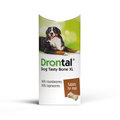 Once your new family member has got used to life in their forever home, you’ll want to start helping to understand some more advanced commands, both for their own wellbeing and your quality of life. But what are the most important things that a well-rounded dog should learn?
Once your new family member has got used to life in their forever home, you’ll want to start helping to understand some more advanced commands, both for their own wellbeing and your quality of life. But what are the most important things that a well-rounded dog should learn?
Tricks like shaking hands and rolling over are all well and good, but the following list is made up of key, practical tasks that your dog should learn early on in life.
Heel
Training your pup to walk to heel is extremely important, even if they spend their walks entirely on a lead. For one thing, having your dog pulling constantly while you’re out and about quickly becomes frustrating. In addition to this, dangerous situations can arise unexpectedly, and you need to be able to count on your dog to listen. If not, they could run out into the road, or another danger spot.
As you walk on the lead, pat your leg on the side that your pet is walking on, while saying “heel” clearly. As is the case with all training, reward them when they display positive behaviour, and withdraw the reward if you do not like what they are doing.
Come
It’s up to you whether you teach your pet to come to you using a particular word, or simply their own name. Either way, the method for teaching them to come is relatively straightforward.
Take your dog to an open space, then move a few steps away from them while saying the command word. Reward them when they reach you, and then repeat, increasing the distance each time.
Sit
Sitting and waiting should be part of your routine when it comes to crossing roads. This is a good safety measure, and helps your dog understand that traffic should be treated with caution.
To teach your pup to sit can be easily managed using either a specific treat such as Pet Munchies Chicken Training Treats, or a few pieces of their usual dry food. Take a reward, and led your dog’s head follow it as you raise it backwards over them, telling them to sit as you do so.
As the head goes up, the puppy will find themselves sitting down - reward this behaviour, and they will quickly make the link between the command and sitting.
Stay
Like coming when called, learning to stay is best taught incrementally. As puppies are an energetic bunch, you’re more likely to have success if you teach them to stay after they’ve had some exercise, so they’re a bit calmer.
Telling them to stay, slowly back away, and when they don’t move, toss them a treat for positive reinforcement.
Down
It’s possible for even the most well-mannered dog to get over-excited, especially when visitors come to the house. When this happens, you can use it as an opportunity to teach your pet not to jump up. Explain to your guests that they should ignore the dog and turn their backs when it jumps. Make sure you reward them with attention when they become calmer, and they’ll be sure to get the message.
Lie down
A related instruction is getting your puppy to lie down on their bed, or another designated spot. They will need to have mastered sitting and staying before you get started with this technique. Get your dog to sit, then coax them into a lying position by lowering a treat to the ground while saying your chosen command, then tell them to stay to keep them there.
Once they have mastered this, you’ll be able to use the command to keep your pup out from under your feet when you need to, and let them know when it’s time for bed.
Written by: Declan








